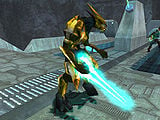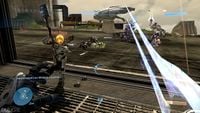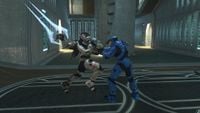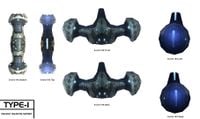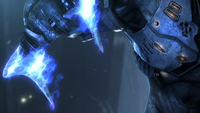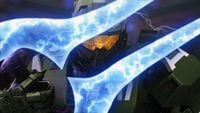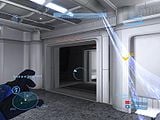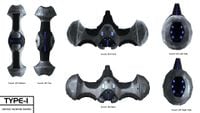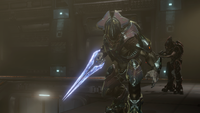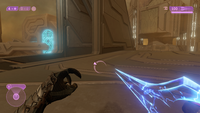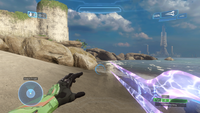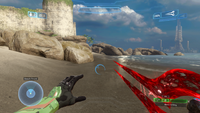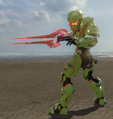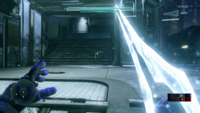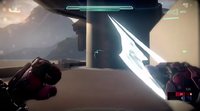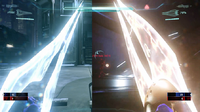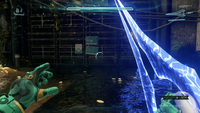Energy sword: Difference between revisions
From Halopedia, the Halo wiki
| Line 85: | Line 85: | ||
==Gallery== | ==Gallery== | ||
===Normal Gallery=== | |||
<gallery> | <gallery> | ||
File:Swordelite.jpg|A Zealot with an Energy Sword as it appears in ''[[Halo: Combat Evolved]]''. | File:Swordelite.jpg|A Zealot with an Energy Sword as it appears in ''[[Halo: Combat Evolved]]''. | ||
| Line 127: | Line 128: | ||
===''Halo 5: Guardians'' REQ Cards=== | ===''Halo 5: Guardians'' REQ Cards=== | ||
<gallery> | <gallery> | ||
File:REQ Card - Energy Sword.png| | File:REQ Card - Energy Sword.png|Energy Sword - Basic Weapon. | ||
</gallery> | </gallery> | ||
Revision as of 16:13, September 20, 2015
- "A noble and ancient weapon, wielded by the strongest of Sangheili, requires great skill and bravery to use, and inspires fear in those who face its elegant plasma blade."
- — Supreme Commander Thel 'Vadamee[1]
The Type-1 Energy Weapon/Sword, commonly known as the energy sword or the plasma sword, is a traditional Sangheili close-quarters weapon.[2][3] The energy sword is intended to express its owner's personal skill, clerical honor, and combat viability.[4]
Background
The energy sword is the signature weapon of the Sangheili and has been their chief weapon of nobility since its creation during one of the Ages of Discovery.[5] The Sangheili pride themselves on their skills with the weapon,[6] which they regard as holy,[7] and believe that it is better for a Sangheili to fall on his sword to redeem his honor than to die dishonorably.[8][9][7] The Sangheili are very strict on who can be trained in the art of swordsmanship; in civilian life only aristocrats are permitted to wield energy swords.[10] Sword wielders are not eligible for marriage, though they may breed with any female they choose, married or otherwise, to ensure successful transmission of "swordsman" genes.[11][3]
Within the Covenant military, use of the energy sword is not restricted to aristocrats.[10] Sangheili Minors are generally not permitted to wield the sword because of the high regard in which it is held,[7] though exceptions have been witnessed.[12][13] It is unknown whether this extends to Majors, as at least one has been witnessed using an energy sword.[13] Ultras, Zealots, Generals, special operations, stealth troops, and honor guardsmen commonly use energy swords. Contrary to the original Covenant, Jul 'Mdama's reformed sect seems less stringent about traditional wielding protocol; as such, members of the Storm class (analogous to Minors) are quite often seen wielding energy swords.[14]
Design details
The energy sword's design is seen as the logical evolution of an ancient lineage of traditional Sangheili weapons, most notably the twin-scythe and the curveblade;[15][3] superficially, the twin-scythe's influence on the energy sword's design is unmistakable.[16] Modern energy swords are manufactured by the Merchants of Qikost, a prominent group of arms makers from one of Sanghelios' moons.[10] The energy sword consists of a curved hilt, which houses an energy storage and generation device, as well as the blade projector; that forms a blade of superheated plasma, stabilized by two small magnetic field generators built into the handle of the weapon—this forms and contains the oval shaped, ionized blades for which the weapon is recognized.[2] The weapon is powered by a small battery that supplies power to the plasma generation device and magnetic field generators which generate and contain the plasma needed to form the blade.[17] The battery's energy is reduced for each successful strike. Each strike from the sword will drain the battery by 10% of its maximum energy output. Once the battery power is fully depleted, the sword will deactivate unless recharged. The horizontal hilt forces the wielder to use a punching motion to stab rather than the thrusting motion of most knives and swords.
Mass-produced energy swords feature a roughly "W"-shaped hilt and have little variation in blade design. Specifically, some models have more rounded blades in lieu of the more common angular style. However, more drastic variations exist. For example, Arbiter Ripa 'Moramee's matching pair of custom-designed[18] swords had basket-style hilt guards and radiated a high degree of ionized plasma,[19] whereas most energy swords contain the blades' plasma with greater efficiency. Some Sangheili special forces units wield blood red-colored energy swords which (ironically, despite their color) burn hotter than more common models.[20][3] Arbiter Thel 'Vadam's personal sword, the Prophets' Bane, was salmon-colored and had a wider blade compared to mass-produced swords.[21][22]
The energy sword contains a fail-safe mechanism that can permanently disable the weapon if the Sangheili wielding it drops it.[23] When dropped, the failsafe engages by deactivating the magnetic field before dispersing the plasma. The plasma then consumes the handle and thus destroys the weapon.[24] The fail-safe is included to prevent enemy infantry from acquiring the weapon and using it, and gives insight to Sangheili tactics.
Combat application
The Type-1 energy sword is extremely powerful in close-quarters combat. A single strike can even penetrate the energy shield systems, armor, and flesh of a Spartan or a Sangheili. This is due to the design of the weapon, which utilizes ionized gas rather than traditional shaped, solid matter—because the energy sword lacks any solid material in which to hold, or impale anything, the sword does not cut or carve in the traditional sense, but rather boils anything it comes into contact with.[17] This allows the weapon to pass through any type of material, including the toughest metal, with ease.[25][26]
Injuries caused by the weapon are often gruesome. Stabs wounds by the energy sword are, in most cases, fatal—as the blade passes through the body, the organs and tissues are cauterized by the extreme temperatures produced by the blades.[27] Body fluids in the area of the stab wound are flash-vaporized upon contact; organs within the area of the stab wounds can suffer life-threatening damage dependent upon which organs are struck. The effects of fluids trapped in organs or arteries and the expansion of heat could lead to ruptures or small explosions, causing additional damage to the victim. Because of the sword's sheer destructive power, dismemberment is another common form of fatality to victims, ranging from decapitation[28] to bodies being sliced in half.[25][29] Loss of limbs is a common injury.[30] Despite the weapon often cutting straight through its target, it is not uncommon for a body impaled on an energy sword to remain suspended—if briefly—on the blade, perhaps due to variable magnetic field strength. The sheer destructive power of the sword makes it a weapon to be feared on any battlefield and is known for its physiological effects on human soldiers.[17]
Advantages
The T-1 energy sword is an extremely powerful and devastating melee weapon in close quarters combat. A single strike can penetrate through the energy shield systems and into the armor and flesh of a Spartan or a Sangheili. Injuries to living creatures by the energy sword can range from bad to gruesome. Stab wounds by the energy sword are in most cases fatal — as the blade passes through the body, the innards of the body are burned and cauterized by the temperatures produced by the blades. The sheer destructive power of the sword makes it a weapon to be feared on any battlefield and it is known for its psychological effects on human soldiers.
Disadvantages
The energy sword's main disadvantage is that it is purely a close-quarters weapon, any weapon outside of the effective range puts the wielder at risk. Furthermore, the energy sword is vulnerable to other magnetic fields, as they can block, disrupt, or possibly even alter the functionality of the sword. Two energy swords clashing together create a small disruption of energy as a result of the same type of magnetic fields clashing together, this clash has a slight area of effect damage that can affect the combatants. As with most other Covenant weapons, the Type-1 Energy Weapon is battery powered, requiring the user to either recharge the weapon or discard it when the power is depleted. Although the handle can generally be used as a club, the energy sword's combat effectiveness at that point is minimal. Finally, due to the energy output, the energy sword can sometimes give away the position of a Sangheili warrior who uses active camouflage.
Gameplay changes
Changes from Halo: Combat Evolved to Halo 2
In Halo: Combat Evolved, the energy sword has a cyan glow, a far less defined edge and makes a dull clunk when striking an object. It is only used by Stealth Sangheili and Zealots. The player cannot wield the energy sword, due to a fail-safe mechanism that vaporizes the weapon when it is not released properly (e.g. being dropped upon death) by the sword-wielder.
In Halo 2, the energy sword is blue with purple undertones, with electrical energy crackling on it when the blade is activated. The white glow seen in Halo: Combat Evolved is also replaced with a more glass-like transparency. In the campaign, it is only used by higher-ranking Sangheili, such as special operations units, Ultras and Zealots, though players can now wield the sword. The sword in campaign has a battery and can only be used effectively against a limited number of enemy forces before the battery runs out. The sword is usable in multiplayer with an infinite battery power. The energy sword has two modes of attacking; a lunge attack and a swing attack.
Changes from Halo 2 to Halo 3
In Halo 3, the sword has more of a light cyan tinge, similar to its appearance in Halo: Combat Evolved, but still has a tint of purple near the handle. It also has an angle near the handle, whereas in the two previous games it was curved. Players are now able to parry with the Sword. The power exerted by the swords hitting each other will drain both players' shields, but will not kill them unless one makes the fatal blow. The sword's lunge attack has been reduced for balancing purposes. Aside from these changes in design and functionality, the power of the sword remains unchanged. In multiplayer, the sword now has a limited battery supply.
Changes from Halo 3 to Halo: Reach
In Halo: Reach, the sword resembles closely to the design used in Halo: Combat Evolved, albeit darker in color. When activated, the sword is capable of lighting up the surrounding area. When unused, the sword rests differently on the SPARTAN and Sangheili character models. The energy sword appears to have been balanced out compared with its earlier incarnations, having a slightly faster swing than its Halo 3 incarnation, its lunge attack now does the same damage as a normal swing, the range has been reduced, and can now be blocked by a well-timed normal melee. Players can no longer lunge immediately after a normal swing. The energy sword also has its own assassination animations when used against Elites or Spartans, replacing the Spartan combat knife and the Sangheili energy dagger; these assassinations do not deplete the sword's charge, nor do they count toward the weapon spree medals Sword Spree, Slice 'N Dice, or Cutting Crew. Elites also hold the sword back more than a Spartan when used as an active weapon. When a player is playing as an Elite and uses the Energy Sword as a primary weapon, the camera will lower a bit; this is due to the Elite hunching down. Finally, parrying does slight damage and can kill a player.
Changes from Halo: Reach to Halo 4
Contrary to Halo: Reach, Halo 4 does not feature the possibility to block a sword lunge with a simple melee. Killing an opponent with an energy sword no longer rewards the player with a Pummel medal, it is instead replaced by the Sword Kill medal. The battery is also drained with every hit, so it's far less viable against Hunters and other powerful enemies.
Changes from Halo 4 to Halo 2 Anniversary
Like the original Halo 2, players cannot parry with the sword. An alternate version of the sword with a red-colored blade, called the Infected Energy Sword, can be used.
Changes from Halo 2 Anniversary to Halo 5: Guardians
The Halo 5: Guardians sword retains the ability to parry from Halo 4. Unlike in past titles players are able to aim with the sword to increase its effective range. A unique version of the energy sword called the Prophets' Bane can be found on Truth as a Legendary weapon.
Trivia

|
See our gameplay information related to Energy sword on its gameplay page. |

|
Browse more images in this article's gallery page. |
- The shape of the energy sword is very similar to the real-life combat weapon, the katara. It was a South Asian weapon and status symbol, similar to the energy sword's symbolization of status among the Elites.
- The energy sword was originally going to be usable in Halo: Combat Evolved, but was cut when the game became a first-person shooter. [31]
- In the Halo 3 Vidoc Et tu Brute? there is an unfinished animation depicting a Jiralhanae Chieftain wielding an energy sword. This is, however, never seen in the hands of Jiralhanae in the final game.
- The Fable 2: Limited Edition comes with "Hal's Sword", a crystal blade shaped like an energy sword for in-game use, to coincide with the use of "Hal's Armor", which resembles MJOLNIR armor.[32]
- A depleted energy sword hilt can still be used offensively. While the damage varies, it has a higher melee rate than any weapon, allowing the player to barrage an enemy with many hits. Once the hilt is swapped for another weapon, however, it cannot be picked up again and often disappears entirely.
Gallery
Normal Gallery
A Zealot with an Energy Sword as it appears in Halo: Combat Evolved.
First-person view of the Energy Sword in Halo 2.
A view of the hilt of the Energy Sword in Halo 3.
- 79621875-Medium.jpg
Two Spartans parrying in the air on Foundry.
An Energy Sword as seen in the Halo Wars announcement trailer.
- ArbiterHWSword.jpg
A study of Arbiter Ripa 'Moramee's custom Energy Swords in Halo Wars.
- HaloWars-ArbiterRipaMoramee.png
Ripa 'Moramee's dual custom Energy Swords in Halo Wars.
John-117 wielding an energy sword against Thel 'Lodamee in Halo Legends: The Package.
A red-colored energy sword variant being used by active camouflaged Special Operations Sangheili from Headhunters motion comic.
An Energy Sword's crosshair in the Halo: Reach Beta.
First-person view of the Energy Sword in the final build of Halo: Reach.
A Zealot with an Energy Sword in Halo: Combat Evolved Anniversary.
First-person view of the Energy Sword in Halo 4.
A Sangheili Commander with an Energy Sword in Spartan Ops.
First-person view of the Energy Sword in Halo 2 Anniversary campaign.
Rtas 'Vadum with an Energy Sword in Halo 2 Anniversary.
- H2A EnergySword-Infected.png
The "Infected" Energy Sword in Halo 2 Anniversary multiplayer.
A Spartan using an Energy Sword on Stonetown.
First-person view of the Energy Sword in the Halo 5: Guardians Multiplayer Beta.
The Energy Sword being used with Smart Scope in the Halo 5: Guardians Multiplayer Beta.
John-117 with an energy sword in Halo 5: Guardians.
First-person view of the Energy Sword in Halo Online.
Halo 5: Guardians REQ Cards
- REQ Card - Energy Sword.png
Energy Sword - Basic Weapon.
List of appearances
Sources
- ^ Halo 2: Special Collector's Edition Manual
- ^ a b Bungie.net: Halo Reach Ordnance Guide: T1 EW/S
- ^ a b c d Halo Waypoint: Energy Sword (defunct)
- ^ Cite error: Invalid
<ref>tag; no text was provided for refs nameduniverse - ^ The Covenant Hall of Murals
- ^ Halo Graphic Novel page 12 - 14
- ^ a b c Halo Encyclopedia page 127
- ^ Halo: The Cole Protocol page 53
- ^ Halo: The Cole Protocol page 141
- ^ a b c Cite error: Invalid
<ref>tag; no text was provided for refs namedessential - ^ Bestiarum Sangheili section
- ^ Halo Wars, introductory cinematic
- ^ a b Halo Legends, The Package
- ^ Halo 4
- ^ Halo 4: The Essential Visual Guide, page 92
- ^ Halo Legends: The Package
- ^ a b c Halo Encyclopedia page 335
- ^ Halo: The Essential Visual Guide, page 10
- ^ Halo Wars
- ^ Halo: Evolutions, Headhunters
- ^ Cite error: Invalid
<ref>tag; no text was provided for refs namedCF - ^ Halo 5: Guardians
- ^ Halo: First Strike page 74
- ^ Halo: Combat Evolved
- ^ a b Halo: The Cole Protocol page 84
- ^ Halo: First Strike page 72
- ^ Halo: Evolutions Midnight in the Heart of Midlothian page 91
- ^ Halo: Evolutions Midnight in the Heart of Midlothian page 101
- ^ Halo: Ghosts of Onyx page 360
- ^ Halo: The Cole Protocol page 30
- ^ Halo: Combat Evolved, E3 2000 Announcement Trailer
- ^ Joystiq: Fable 2's Spartan armor and energy sword pictured
|
| |||||||||||


